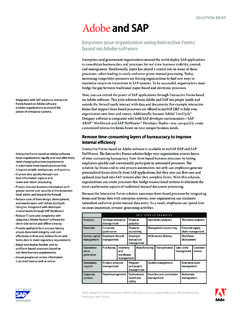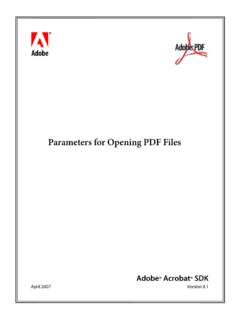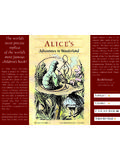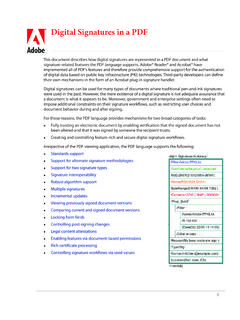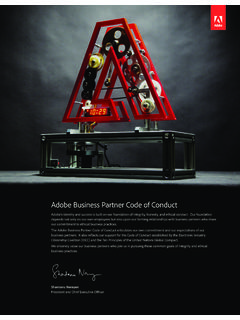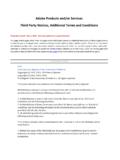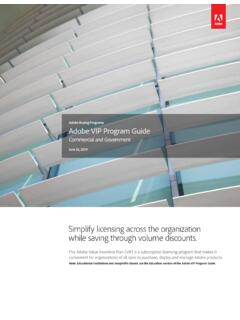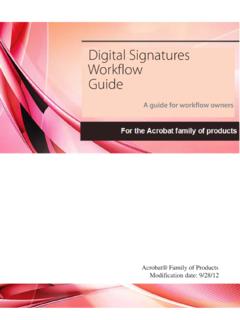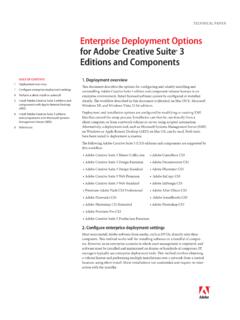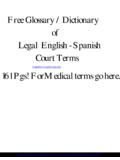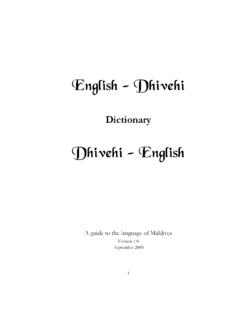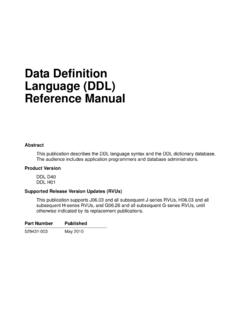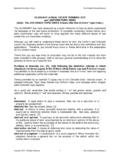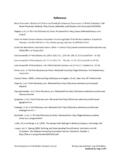Transcription of Digital Signatures in a PDF - adobe.com
1 1 Digital Signatures in a PDFThis document describes how Digital Signatures are represented in a PDF document and what signature-related features the PDF language supports. adobe Reader and Acrobat have implemented all of PDF s features and therefore provide comprehensive support for the authentication of Digital data based on public key infrastructure (PKI) technologies. Third-party developers can define their own mechanisms in the form of an Acrobat plug-in signature handler. Digital Signatures can be used for many types of documents where traditional pen-and-ink Signatures were used in the past. However, the mere existence of a Digital signature is not adequate assurance that a document is what it appears to be. Moreover, government and enterprise settings often need to impose additional constraints on their signature workflows, such as restricting user choices and document behavior during and after signing.
2 For these reasons, the PDF language provides mechanisms for two broad categories of tasks: Fully trusting an electronic document by enabling verification that the signed document has not been altered and that it was signed by someone the recipient trusts. Creating and controlling feature-rich and secure Digital signature of the PDF viewing application, the PDF language supports the following: Standards support Support for alternate signature methodologies Support for two signature types Signature interoperability Robust algorithm support Multiple Signatures Incremental updates Viewing previously signed document versions Comparing current and signed document versions Locking form fields Controlling post-signing changes Legal content attestations Enabling features via document-based permissions Rich certificate processing Controlling signature workflows via seed valuesDigital Signatures in a PDFR epresenting a signature in a PDF fileAcrobat Family of Products Representing a signature in a PDF fileIn a PDF, signature information is contained in a signature dictionary .
3 Objects in the dictionary are defined by the PDF Reference. The signature dictionary can reference, or be referenced by, other dictionaries, and it usually is (Figure 1). The entries in these dictionaries determine the nature and features of the signature, and by extension, what data can be available to any PDF viewer designed to process the signature data. While other viewers may vary in their support of PDF language features, The Acrobat family of products supports all of those features. At a high level, these features can be grouped into these categories: Adding a Digital signature to a document. Checking that signature for validity. Permissions and restrictions that control the signature , PDF includes features which are related to these activities but are not essential to them.
4 For example, support for adding signing reasons is tangential to signing, but valuable for many :For complete PDF language details, refer to the PDF Reference at 1 PDF language dictionaries )LOWHU VLJQDWXUH KDQGOHU %\WH5 DQJH GRFXPHQW UDQJH 5 HIHUHQFH Q VLJ UHI GLFWV &RQWHQWV VLJ YDOXH 6XE)LOWHU VLJQDWXUH IRUPDW REM 6 LJQDWXUH GLFWLRQDU\ 2 WKHU VWXII REM )LHOG GLFWLRQDU\ 3 HUPV 'RF0'3 REM ,' ! 3 HUPV 85 !REM 3 HUPLVVLRQV GLFWLRQDU\ 6LJ)ODJV RSWLRQDO RU /RFN&HUWLILFDWLRQ VLJQDWXUH GHILQH XVDJH ULJKWV)LHOG OHYHO SHUPLVVLRQV $FWLRQV $OO _ ,QF _ ([F )LHOGV )LHOG QDPHV 9 )RUP >IRUP ILHOG ULJKWV@ 'RFXPHQW >)XOO6 DYH@ )7 ILHOG W\SH H J 6LJ 69 RSWLRQDO VHHG YDOXH 'RF ORFNHG RQ DSSURYDO VLJ $OORZ VLJQ DQQRWV HWF 3 _ _ 9 LI VLJQHG D VLJ GLFW REM ,' 7\SH 6 LJREM )LHOG ORFN GLFWLRQDU\ 7\SH 6LJ)LHOG/RFN 3 $FWLRQ $OO85 7 UDQVIRUP3 DUDPV'RF0'3 7 UDQVIRUP3 DUDPV)LHOG0'3 7 UDQVIRUP3 DUDPV 3 )RUP(.]
5 >IRUP ILHOG ULJKWV@ () >HPEHGGHG ILOH ULJKWV@ $QQRWV >DQQRW ULJKWV@ 6 LJQDWXUH >0 RGLI\@7 UDQVIRUP0 HWKRG VHWV ZKDW 7 UDQVIRUP3 DUDPV DUH XVHG 7\SH 6LJ5HI)LHOG0'3'RF0'385 7 UDQVIRUP3 DUDPV 7 UDQVIRUP0 HWKRGREM 6 LJQDWXUH UHIHUHQFH GLFW 7\SH 69 )LOWHU 6 LJQDWXUH KDQGOHU &HUW &HUWLILFDWH 69 GLFWLRQDU\ 6XE)LOWHU 6 LJQDWXUH HQFRGLQJ )I 6 SHFLI\ UHTXLUHG HQWULHV REM 6 HHG YDOXH GLFWLRQDU\ $GG5HY,QIR (PEHG UHY VWDWXV 'LJHVW0 HWKRG $OJRULWKP 6 XEMHFW ,GHQWLI\ FHUWLILFDWHV 2 WKHU VWXII REM &HUWLILFDWH 69 GLFWLRQDU\ 7 LPH6 WDPS 76 GLFWLRQDU\ 0'3 )RUFH FHUWLILFDWLRQ VLJ 5 HDVRQV 6 LJQLQJ UHDVRQV OLVW 9 69 SDUVHU FDSDELOLW\ /HJDO$WWHVWDWLRQ $WWHVWDWLRQV 7\SH 69&HUW )I 6 SHFLI\ UHTXLUHG HQWULHV Digital Signatures in a PDFP ublic key infrastructureAcrobat Family of Products Public key infrastructurePDF s Digital signature capabilities are designed for compatibility with all the standards associated with mainstream public key infrastructures (PKI) deployed in enterprise and government settings.
6 A PKI is the set of people, policies, procedures, hardware, and software used in creating, distributing, managing, and revoking, and using the Digital IDs that contain the public/private key pairs used when signing a PDF. In the context of PDF signature workflows, PKI generally refers to the Digital ID issuers, users, administrators, and any hardware or software used in those workflows. PDF viewers that implement and conform to the PDF language specification are able to interact with all of these components in a seamless and robust 2 Common PKI elements in signature workflowsWhen signing an important paper document, a person usually signs it in front of a notary public or other trusted authority after providing them satisfactory evidence of their identity. Because the notary is deemed trustworthy, you can trust the signature the notary witnesses.
7 Using a PKI is a method of providing a similar kind of common PKI components directly related to providing trust include: Certificate authority (CA): An ultimate trust authority that sells or issues Digital IDs (such as Verisign or Geotrust). The CA signs it s own certificate (self-signs) and its certificate is typically the root certificate at the top of the certificate chain. Intermediate certificates (ICAs): A type of CA whose certificate resides in the certificate chain between the end entity and root certificates. The certificate is not self-signed, and the ICA often provides services such as policies, timestamping, revocation lists, etc. End entity certificate (EE): The signer s certificate and the last element of a signing chain. By definition, an end entity certificate does not contain the basic constraint value CA.
8 'LJLWDO ,' VWRUHG RQ WKH VLJQHU V PDFKLQH WRNHQ VHUYHU HWF &HUWLILFDWH FKDLQ6 LJQHUV3 XEOLF NH\ FHUWLILFDWH VWRUH $FUREDW VWRUH :LQGRZV FHUW VWRUH /'$3 VWRUH HWF 5 HYRFDWLRQ GDWD VWRUH /RFDO FHUWLILFDWH UHYRFDWLRQ OLVWV &5/ /'$3 &5/ RQOLQH VWDWXV FKHFN HWF 3 ULYDWH NH\ EDFNXS VWRUH2 IWHQ WKH FRPSDQ\ LVVXHV ,' WR HPSOR\HHV &DQ GHILQH SROLFLHV WUXVW DQFKRU HWF &RPSDQ\ RU UG SDUW\ WLPHVWDPS VHUYHU GLJLWDO LG HQG HQWLW\ FHUW 5 RRW FHUW &$ VHOI VLJQHG,QWHUPHGLDWHFHUWLILFDWH V 'LJLWDO ,' FUHDWLRQ WRRO(QWHUSULVH RZQHG 3., HOHPHQWV$GPLQD igital Signatures in a PDFPKI, PDF, and signingAcrobat Family of Products 4 Digital ID: An electronic representation of data based on the ITU-T v3 standard, associated with a person or entity. It is stored in a password-protected file on a computer or network, a USB token, a smart card, etc.)
9 A Digital ID contains a public key certificate, a private key, and other data. Public key certificate: A file that contains the numeric public key portion of a public/private key pair along with the associated extensions and attributes used to define the certificates owner, validity period, and usage. Private key: The secret key in a PKI system, used to validate incoming messages and sign outgoing ones. A Private Key is always paired with its Public Key during those key the Digital ID and its issuing entities are central to any PKI, the PKI also includes many other enterprise-owned and 3rd party items. A PKI administrator will usually manage the creation and distribution of Digital IDs, LDAP servers, timestamp servers, revocation lists, and other items. The PDF language supports all the data needed to interface with those PKI, PDF, and signingPDF includes support for Signatures to be embedded in the document itself, rather than managed as separate data or added on to an existing document format.
10 This means that the viewing application can perform certain types of modification without invalidating the signature. With other Digital signature formats, the user may need either two applications to handle both the document and the signature, or would need to manage two separate files for each signed Digital signature in a PDF document is associated with a signature handler. The signature is placed in a PDF signature dictionary which contains the name of the signature handler which will be used to process that signature (Figure 3). The signature handler built into adobe Acrobat leverages Public/Private Key (PPK) cryptography technologies. PPK is based on the idea that a value encrypted with a private key can only be decrypted using the public key (the reverse may also be true when encrypting documents for specific recipients, but that is outside the scope of this document).
